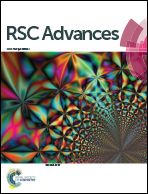Preparation, characterization and electrochemical measurement of porous carbon derived from poly(furfuryl alcohol)/polyvinylpyrrolidone electrospun nanofibers
Abstract
In this work, porous carbon materials produced from poly(furfuryl alcohol) (PFA)/polyvinylpyrrolidone/silica composite electrospun fibers have been prepared by sol–gel, carbonization and etching processes. PFA acts as carbon source, tetraethyl orthosilicate (TEOS) serves as a template and poly(propylene oxide)-block-poly(ethylene oxide)-block-poly(propylene oxide) triblock copolymer Pluronic F127 works as a structure-directing agent. Three samples (C-1, C-2 and C-3) with different pore structures have been prepared. The structures of the pores are demonstrated to be dependent on the amount of TEOS and the presence or absence of F127 by means of various characterization methods. After the carbonization process, carbon material yields of 35.5%, 38.6% and 40.3% are obtained, corresponding to the samples of electrospun nanofibers M-1, M-2 and M-3, respectively. When further treated by the hydrofluoric acid (HF) etching, the regular morphology of the electrospun nanofibers disappears gradually by prolonging the etching time, and the as-obtained typical product C-3 has a high specific surface area (SSA) of 897 m2 g−1 and a specific capacitance of 205.5 F g−1 at the scan rate of 20 mV s−1 in KOH electrolyte solution. It is revealed that the structure of the pores and the high SSA are responsible for the excellent electrochemical performance of the porous carbon materials. According to the results, the typical product C-3 is a promising electrode material for electrical double-layer capacitors.


 Please wait while we load your content...
Please wait while we load your content...